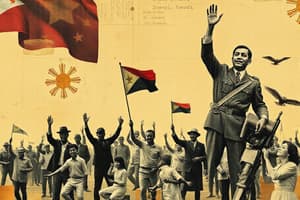Podcast
Questions and Answers
What was the aim of the Cavite Mutiny according to Jose Montero y Vidal's account?
What was the aim of the Cavite Mutiny according to Jose Montero y Vidal's account?
- To express objection against the injustices of the Spanish government
- To achieve independence by overthrowing the Spanish government (correct)
- To secure materials and education advancements in the country
- To establish a new form of government with a leader named José Burgos
According to Governor-General Izquierdo's account, who was believed to have stimulated and prepared the mutiny?
According to Governor-General Izquierdo's account, who was believed to have stimulated and prepared the mutiny?
- The central government in Spain
- The Spanish clergy and friars (correct)
- The American publicists
- The native laborers at Fort San Felipe
What did Governor-General Izquierdo insist was a signal of objection against the injustices of the Spanish government?
What did Governor-General Izquierdo insist was a signal of objection against the injustices of the Spanish government?
- Not being paid for tobacco crops (correct)
- Depriving friars of powers in civil government
- Being forced to perform labor in the Cavite arsenal
- The removal of privileges enjoyed by laborers at Fort San Felipe
According to Trinidad Pardo de Tavera's account, what was the main purpose of the Filipinos during the mutiny?
According to Trinidad Pardo de Tavera's account, what was the main purpose of the Filipinos during the mutiny?
In Edmund Plauchut's account, what was identified as the immediate cause of the Cavite Mutiny?
In Edmund Plauchut's account, what was identified as the immediate cause of the Cavite Mutiny?
What did Jose Montero y Vidal attribute as one of the factors that led to the idea of achieving independence?
What did Jose Montero y Vidal attribute as one of the factors that led to the idea of achieving independence?
What was the primary cause of the Cavite mutiny, according to Spanish accounts?
What was the primary cause of the Cavite mutiny, according to Spanish accounts?
Who were the key participants in the Cavite mutiny, according to Spanish accounts?
Who were the key participants in the Cavite mutiny, according to Spanish accounts?
What was the outcome of the Cavite mutiny?
What was the outcome of the Cavite mutiny?
How many people were involved in the Cavite mutiny?
How many people were involved in the Cavite mutiny?
Which of the following best describes the significance of the Cavite mutiny?
Which of the following best describes the significance of the Cavite mutiny?
What was the name of the Spanish arsenal in Cavite, where the mutiny took place?
What was the name of the Spanish arsenal in Cavite, where the mutiny took place?
Flashcards are hidden until you start studying
Study Notes
The Cavite Mutiny
- The Cavite Mutiny was an uprising of Filipino military personnel against the Spanish government in the Philippines on January 20, 1872.
- The mutiny was sparked by the removal of privileges enjoyed by laborers of the Cavite arsenal, including exemption from tribute and forced labor.
Causes of the Cavite Mutiny
- The mutiny was fueled by the spread of democratic and republican ideas from Spain and the American publicists.
- The cruel policies of the insensitive governor and the Spanish government's treatment of the native Filipinos contributed to the uprising.
- The removal of privileges and the introduction of personal taxes and forced labor for Filipino laborers in the Cavite arsenal were the immediate causes of the mutiny.
Accounts of the Mutiny
- According to José Montero y Vidal, the mutiny was an attempt to remove and overthrow the Spanish colonizers in the Philippines.
- Governor-General Izquierdo believed that the mutiny was stimulated and prepared by the native clergy, mestizos, and lawyers as a signal of objection against the injustices of the government.
- Trinidad Pardo de Tavera saw the event as a simple mutiny, with the goal of securing material and education advancements in the country, but not independence from Spain.
- Edmund Plauchut traced the immediate cause to a peremptory order from the Governor-General Izquierdo, exacting personal taxes and forced labor from the Filipino laborers.
Consequences of the Mutiny
- The mutiny was unsuccessful, and government soldiers executed many of the participants.
- The event marked the beginning of Filipino nationalism, which would eventually lead to the Philippine Revolution.
- The Spanish government cracked down on the burgeoning nationalist movement, fearing the loss of control over the Philippines.
Studying That Suits You
Use AI to generate personalized quizzes and flashcards to suit your learning preferences.




